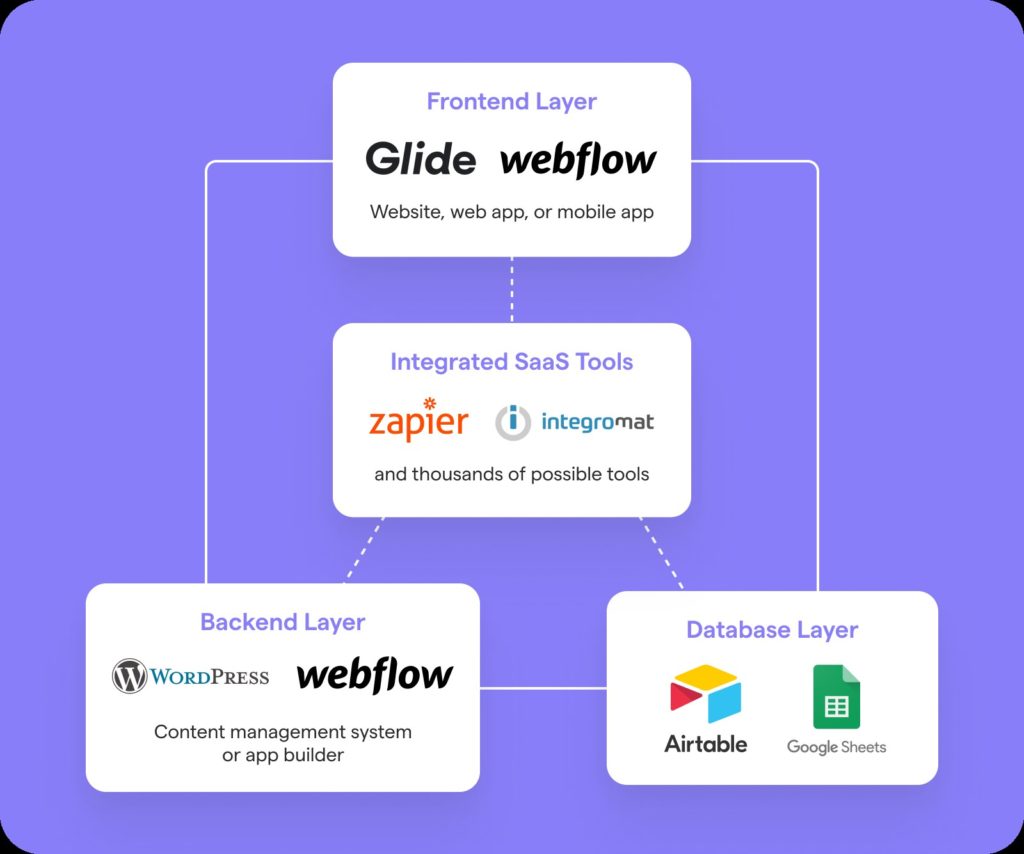Businesses of all sizes are building their own custom apps, databases, workflows and much, much more… so, what are you waiting for?
Bill Gates says you should hire lazy people. No, seriously. He famously said, “I choose a lazy person to do a hard job. Because a lazy person will find an easy way to do it.” And maybe he has a point – new ideas, ways of doing things and neater processes are not the domain/ownership of computer programmers. (Hackers maybe. Lazy hackers, definitely.) Less so often means more. More simplicity, more refinement, and more clarity. So, finding the lowest hanging fruit pays dividends. The same applies to the idea of No-Code technology.
Many of the challenges businesses tend to face don’t actually require fully bespoke apps or solutions, and as unique as those challenges may be, large parts of the solutions are frequently straightforward and repetitive. Speed reduces time and cost, while increasing flexibility and agility, and coding up an app from scratch is neither fast nor cheap. Thus, the case is made for No-Code technology; postulating the incredibly tantalizing and potentially lucrative hypothesis: “What if you could code, without actually needing to know how to code?”
No-Code technology sets out to open development up to wider groups, with a far lower barrier to entry, enabling those without the knowledge or experience to code custom software to create apps, websites, databases, dashboards, and various other types of tools without having to programme them. Instead, the No-Code platform does that work in the background and allows their clients to generate solutions using a suite of compatible, collatable tools in a slick and easy way, to interpret the user interface (UI). Building a custom tool by merely dragging and dropping, and the click of a mouse. Succinctly and humorously described by some as attempting to “occupy the white space between an Excel file and a custom web application”, No-Code and Low-Code platforms have been steadily exploding in popularity over the last few years and have likely already impacted your life (if not your workflow) in numerous ways, even if they’ve escaped your direct notice to date. Have you got an Apple I-phone? Check out the “Shortcuts”. These are essentially No-Code functions that you can connect yourself, you No-Code wizard – take a photo and post it to Instagram; turn on the radio when you turn off your morning alarm. Try it out.
Meanwhile, companies like Airtable and Zapier have already achieved multi-billion valuations in this nascent space, as more and more competitors and products for specific niches bubble up around them. Put together, the growing suite of No-Code tools available allow businesses of any and every size to have their own custom tech stack. Here is a great example of how it might look, from Glide Apps:

No-Code technologies also come with some downsides, which may be significant depending on your business needs, and it’s important to understand the downsides before you rush into embracing them. Caveat Emptor applies as it always does on some level in the world of business, and something, that might seem like a massive up-front cost reduction in the short term, could potentially turn into snowballing and locked-in expenses later on down the line.
The structured templates provided can be great for a wide variety of use cases, but the moment you start butting up against their limits, you may be completely lacking the ability to implement the logic required to fix it and missing the flexibility of custom code. Worse yet, on many of the platforms you don’t necessarily own your own source code and can find yourself quite locked into your vendors of choice. Even those vendors that do make your source code accessible don’t always make it easy or feasible to understand what’s going on under the hood (and why would they, when they’d be facilitating your possible departure?). The workings of code can be opaque and confusing on the best of days, but with No-Code technology you may end up with complete knowledge of what goes in and comes out of your application… while the implementation is intentionally and fully obfuscated behind the platform you chose to build on.
If you can collaborate more easily between your business teams and your development team, that’s worth a lot in the trade-off and Low-code and No-code tools seem poised and almost inevitable in their quest to open app development up to wider groups. They may now, however, be putting developers on the path to extinction. While it is easy to think of tactical apps fulfilling simple functions and how AI will quickly fuel the capability to code more and more complex systems with easier and easier inputs, that may simply portend an inflection point in the industry similar to the way cloud computing changed it 15 years ago. If you think it or say it, the code will be there, and the role of traditional developers in business models may change, but for the near future there will still likely be those who have the hard-earned specialization in the tools and then those even more specialized in the creation of the tools themselves.
Looking even further down the road however, many wise prognosticators seem to hold the view that we’re on the cusp of something that has the potential to truly change the way we build our digital technology.
“The future of coding is no coding at all.” – Chris Wanstrath, CEO at GitHub


